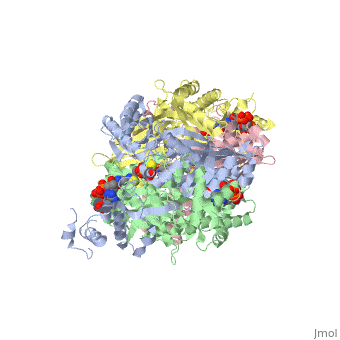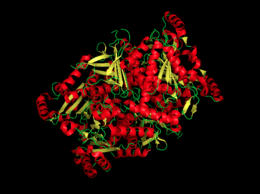Sandbox Reserved 765
From Proteopedia
(Difference between revisions)
| Line 33: | Line 33: | ||
| - | + | Contagious diseases are increasingly becoming a major public health issue. The shikimate pathway is often used for the advancement of antimicrobial mixures to fight against these diseases. This process only takes place in prokaryotes, fungi and plants. '''Chorismate synthase''' is the enzyme that is used in the shikimate pathway, which catalyzes the coversion of phosphoenol pyruvate to chorismate. Chorismate Synthase is an enzyme part of the lyase family. Studying this enzyme and the roles that it plays in many diseases, inhibition of this reaction can lead to oral treatment for infectious diseases and further growth. This enzyme is responsible for catalyzing the following reversible reaction: | |
5-enolpyruvylshikimate-3-phosphate <--> Chorismate + Phosphate. | 5-enolpyruvylshikimate-3-phosphate <--> Chorismate + Phosphate. | ||
| Line 39: | Line 39: | ||
==Structural Content== | ==Structural Content== | ||
| - | + | Chorismate synthase is a homo 4-mer structure, which is composed of four identical monomer subunits. The crystal structure of chorismate synthase was solved at 2.0 Å using the multiwavelength anomalous dispersion (MAD) method. Each monomer within the structure has a β-α-β fold motif. One of the four monomers differs in structure slight close to the active site. This difference makes the active site a lot more accessible, making this monomer an “open” conformation. | |
[[Image:Chorismate synthase sequence.png|thumb|right|240px|Figure 2. This image is representative of the sequence of chorismate synthase.]] | [[Image:Chorismate synthase sequence.png|thumb|right|240px|Figure 2. This image is representative of the sequence of chorismate synthase.]] | ||
| - | + | The image to the right is the sequence of chorismate synthase. | |
Revision as of 16:38, 2 December 2013
| This Sandbox is Reserved from Sep 25, 2013, through Mar 31, 2014 for use in the course "BCH455/555 Proteins and Molecular Mechanisms" taught by Michael B. Goshe at the North Carolina State University. This reservation includes Sandbox Reserved 299, Sandbox Reserved 300 and Sandbox Reserved 760 through Sandbox Reserved 779. |
To get started:
More help: Help:Editing |
Chorismate Synthase
| |||||||||||



